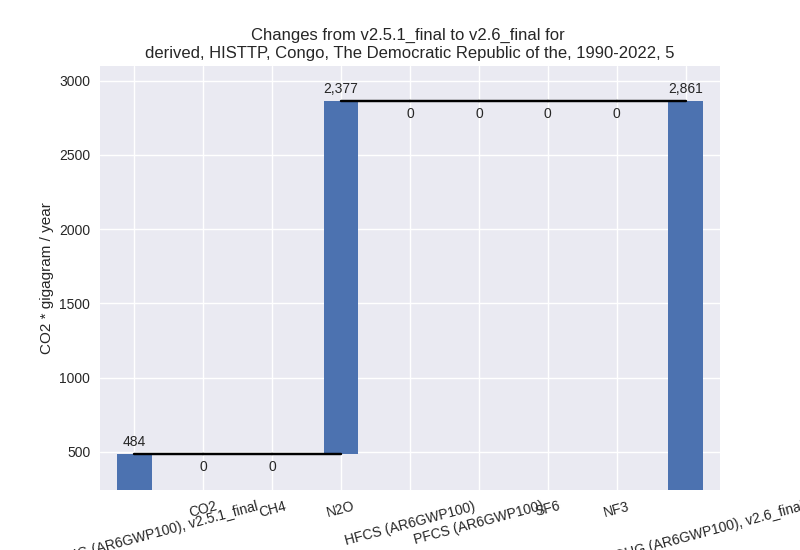Changes in PRIMAP-hist v2.6_final compared to v2.5.1_final for Congo, The Democratic Republic of the
2024-09-24
Johannes Gütschow
Change analysis for Congo, The Democratic Republic of the for PRIMAP-hist v2.6_final compared to v2.5.1_final
Overview over emissions by sector and gas
The following figures show the aggregate national total emissions excluding LULUCF AR6GWP100 for the country reported priority scenario. The dotted linesshow the v2.5.1_final data.
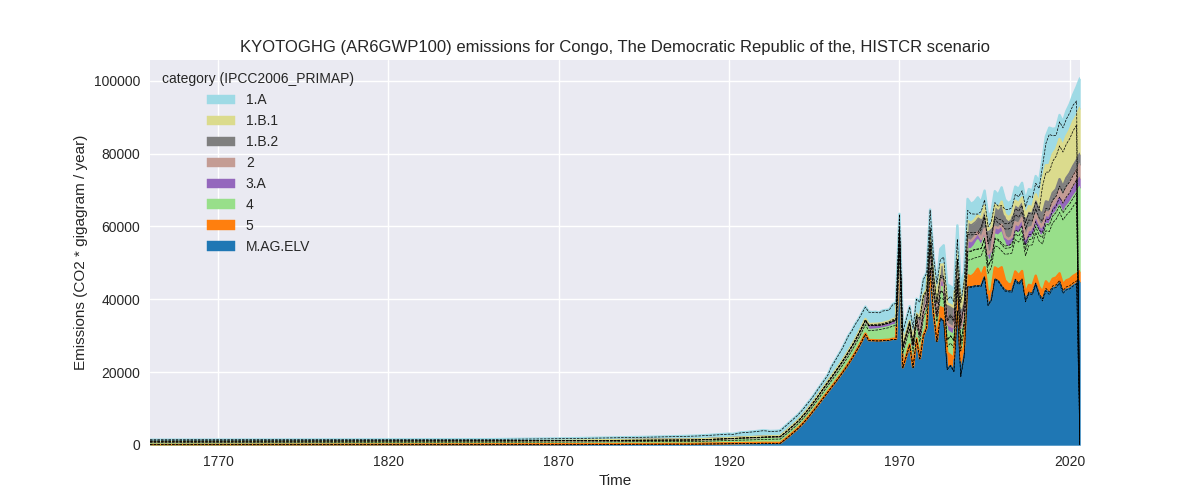
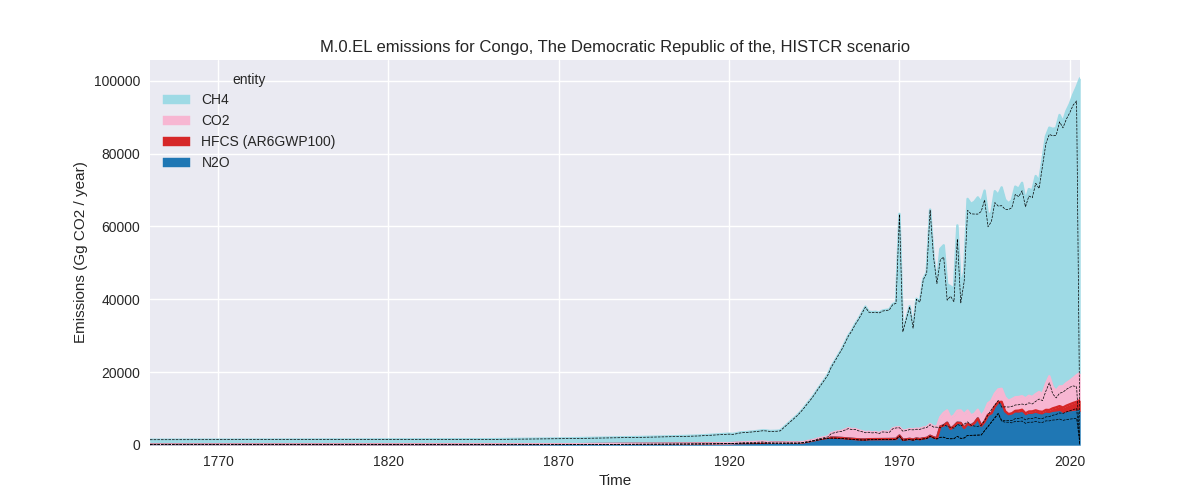
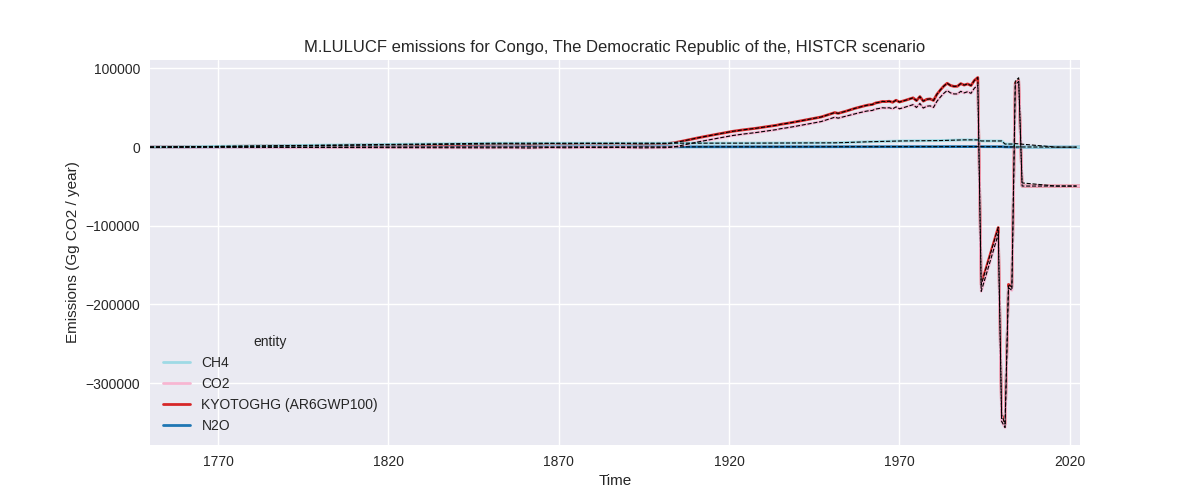
The following figures show the aggregate national total emissions excluding LULUCF AR6GWP100 for the third party priority scenario. The dotted linesshow the v2.5.1_final data.
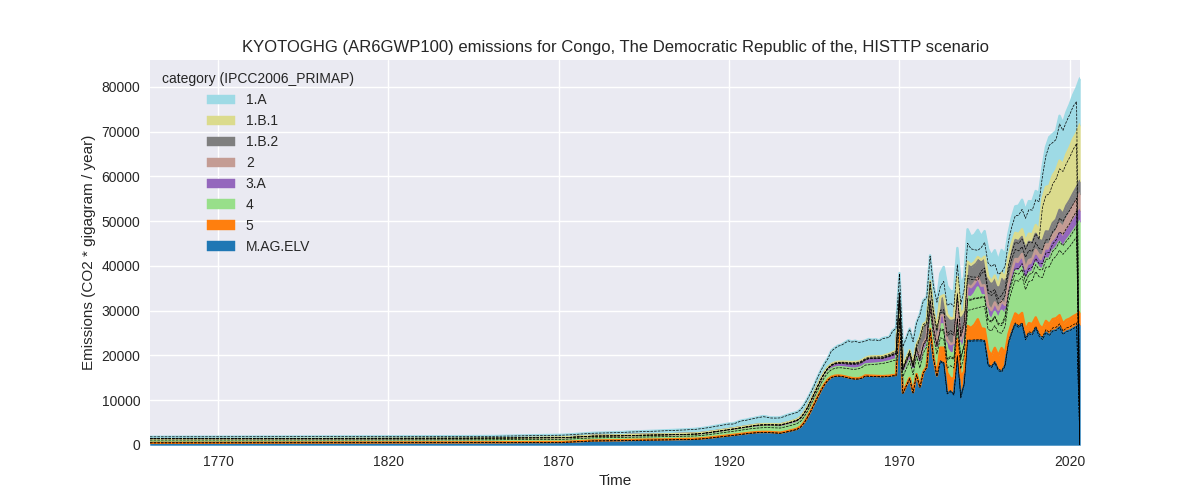

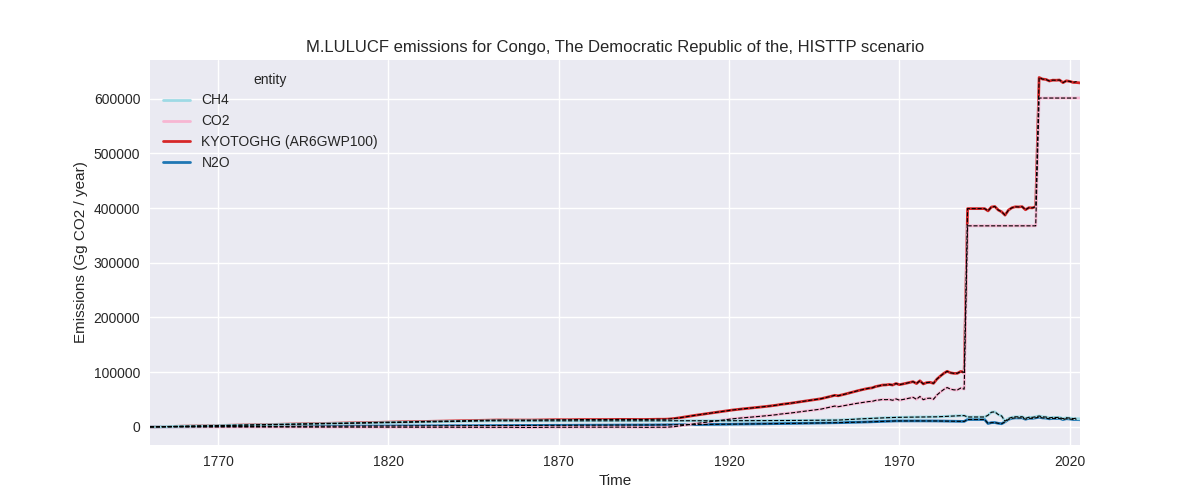
Overview over changes
In the country reported priority scenario we have the following changes for aggregate Kyoto GHG and national total emissions excluding LULUCF (M.0.EL):
- Emissions in 2022 have changed by 4.0%% (3806.88 Gg CO2 / year)
- Emissions in 1990-2022 have changed by 3.4%% (2489.80 Gg CO2 / year)
In the third party priority scenario we have the following changes for aggregate Kyoto GHG and national total emissions excluding LULUCF (M.0.EL):
- Emissions in 2022 have changed by 4.0%% (3070.54 Gg CO2 / year)
- Emissions in 1990-2022 have changed by 4.5%% (2429.83 Gg CO2 / year)
Most important changes per scenario and time frame
In the country reported priority scenario the following sector-gas combinations have the highest absolute impact on national total KyotoGHG (AR6GWP100) emissions in 2022 (top 5):
- 1: 5, N2O with 1881.57 Gg CO2 / year (223.4%)
- 2: 1.A, CO2 with 1281.72 Gg CO2 / year (27.3%)
- 3: 4, CH4 with 709.80 Gg CO2 / year (3.3%)
- 4: 4, N2O with -106.13 Gg CO2 / year (-21.1%)
- 5: 2, HFCS (AR6GWP100) with 39.49 Gg CO2 / year (1.5%)
In the country reported priority scenario the following sector-gas combinations have the highest absolute impact on national total KyotoGHG (AR6GWP100) emissions in 1990-2022 (top 5):
- 1: 5, N2O with 2376.77 Gg CO2 / year (491.2%)
- 2: 4, CH4 with 88.47 Gg CO2 / year (0.7%)
- 3: 1.A, CO2 with 49.01 Gg CO2 / year (1.4%)
- 4: 4, N2O with -25.88 Gg CO2 / year (-8.7%)
- 5: 2, HFCS (AR6GWP100) with 1.20 Gg CO2 / year (0.1%)
In the third party priority scenario the following sector-gas combinations have the highest absolute impact on national total KyotoGHG (AR6GWP100) emissions in 2022 (top 5):
- 1: 5, N2O with 1881.57 Gg CO2 / year (223.4%)
- 2: 1.A, CO2 with 676.46 Gg CO2 / year (27.3%)
- 3: 4, CH4 with 578.72 Gg CO2 / year (3.1%)
- 4: 4, N2O with -106.13 Gg CO2 / year (-21.1%)
- 5: 2, HFCS (AR6GWP100) with 39.49 Gg CO2 / year (1.5%)
In the third party priority scenario the following sector-gas combinations have the highest absolute impact on national total KyotoGHG (AR6GWP100) emissions in 1990-2022 (top 5):
- 1: 5, N2O with 2376.77 Gg CO2 / year (491.2%)
- 2: 4, CH4 with 51.65 Gg CO2 / year (0.5%)
- 3: 4, N2O with -25.88 Gg CO2 / year (-8.7%)
- 4: 1.A, CO2 with 25.87 Gg CO2 / year (1.2%)
- 5: 2, HFCS (AR6GWP100) with 1.20 Gg CO2 / year (0.1%)
Notes on data changes
Here we list notes explaining important emissions changes for the country. ’' means that the following text only applies to the TP time series, while means that it only applies to the CR scenario. Otherwise the note applies to both scenarios.
- N2O emissions in category 5 (“other”) are much higher because we removed FAOSTAT data (and use EDGAR). This has also influenced CH4 and N2O emissions i the waste sector (CR, TP)
- Energy CO2 emissions are higher in 2022 because EI data has changed for 2021 and 2022 from EI2023 to EI2024.
Changes by sector and gas
For each scenario and time frame the changes are displayed for all individual sectors and all individual gases. In the sector plot we use aggregate Kyoto GHGs in AR6GWP100. In the gas plot we usenational total emissions without LULUCF. ## country reported scenario
2022
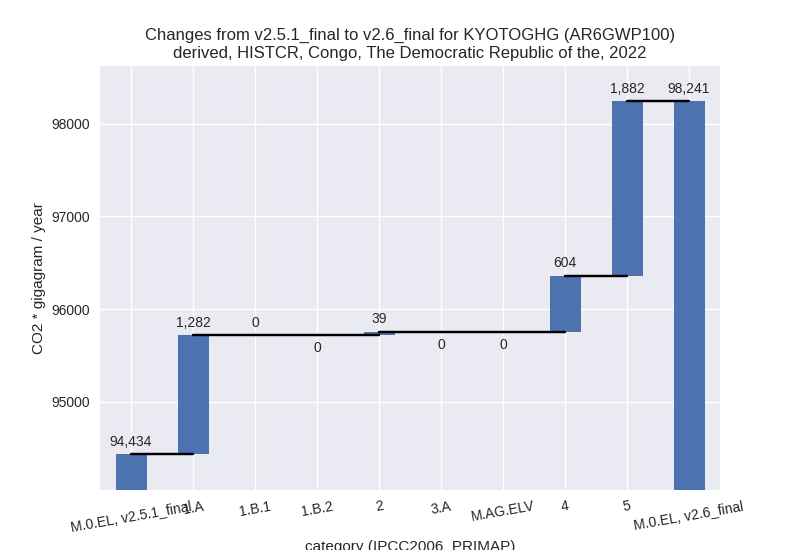
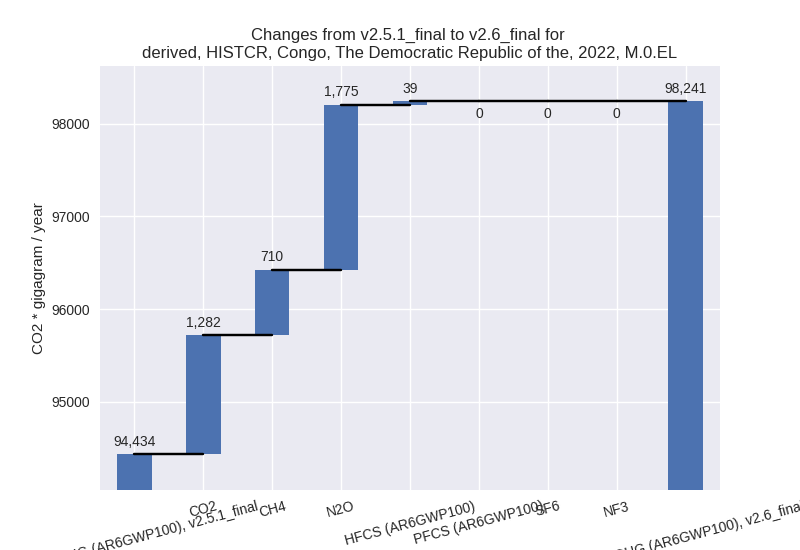
1990-2022
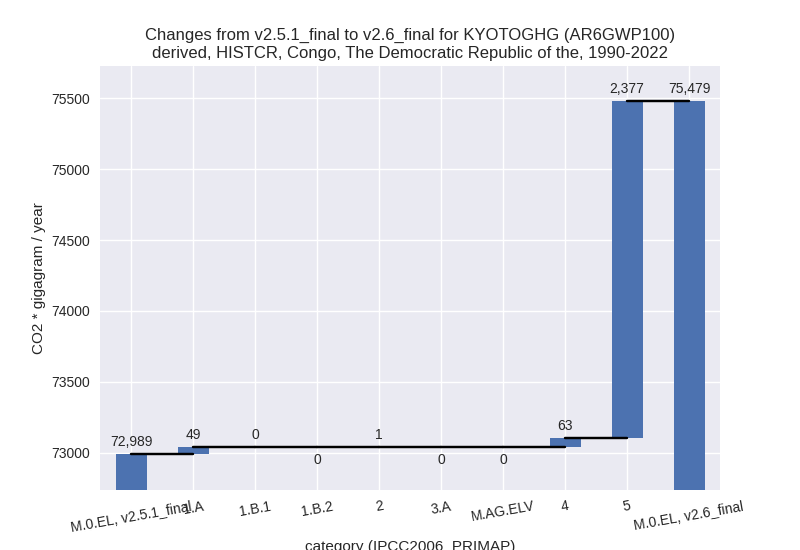
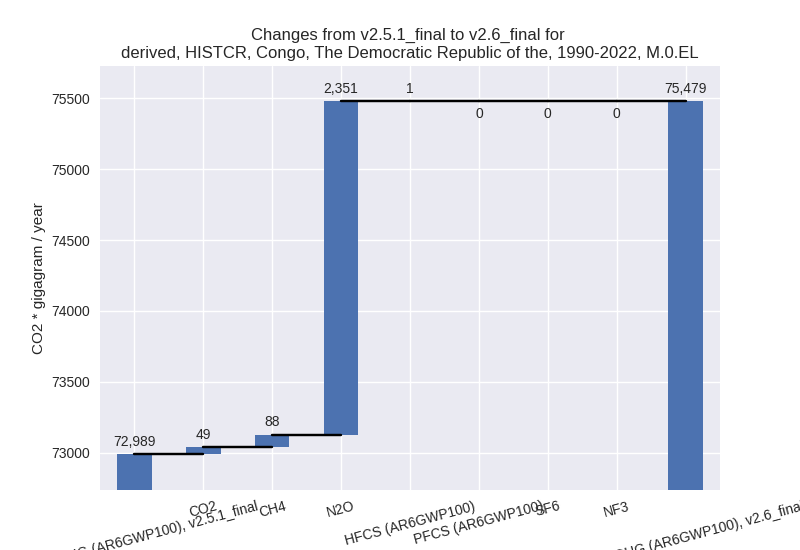
third party scenario
2022

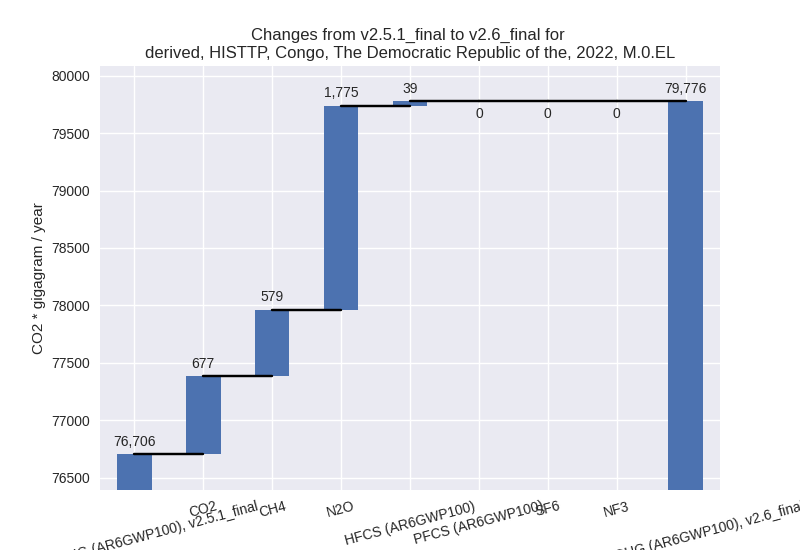
1990-2022
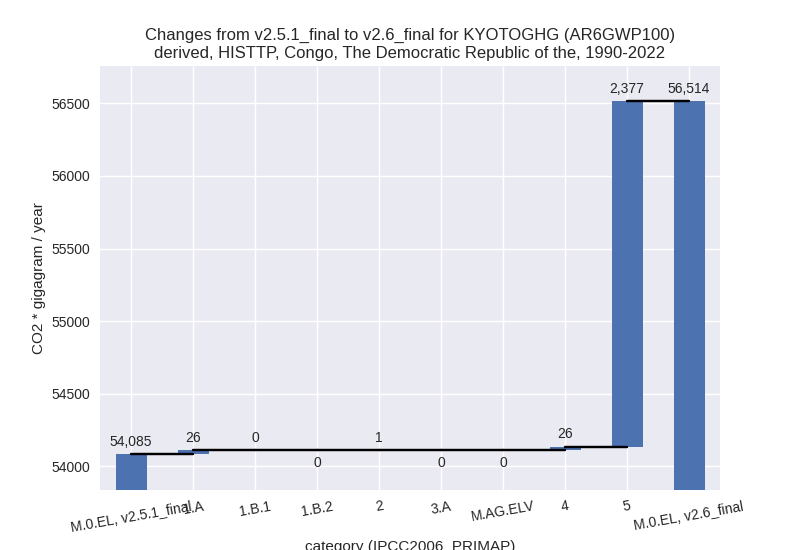
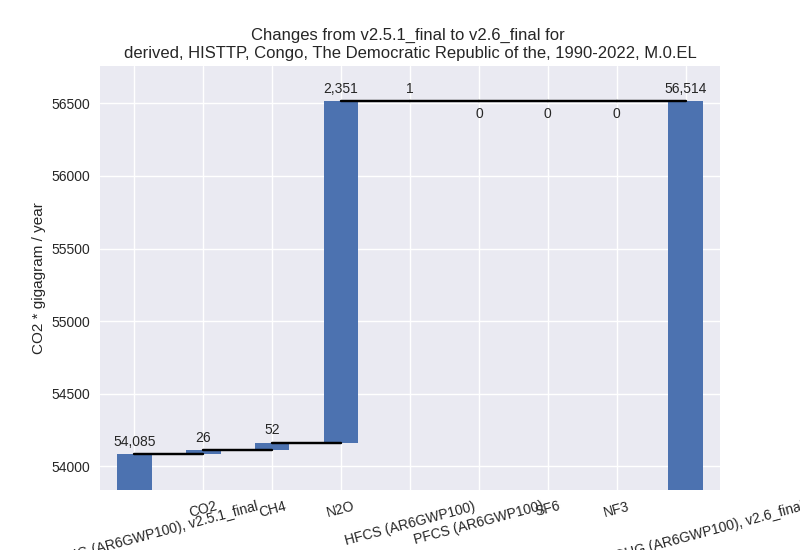
Detailed changes for the scenarios:
country reported scenario (HISTCR):
Most important changes per time frame
For 2022 the following sector-gas combinations have the highest absolute impact on national total KyotoGHG (AR6GWP100) emissions in 2022 (top 5):
- 1: 5, N2O with 1881.57 Gg CO2 / year (223.4%)
- 2: 1.A, CO2 with 1281.72 Gg CO2 / year (27.3%)
- 3: 4, CH4 with 709.80 Gg CO2 / year (3.3%)
- 4: 4, N2O with -106.13 Gg CO2 / year (-21.1%)
- 5: 2, HFCS (AR6GWP100) with 39.49 Gg CO2 / year (1.5%)
For 1990-2022 the following sector-gas combinations have the highest absolute impact on national total KyotoGHG (AR6GWP100) emissions in 1990-2022 (top 5):
- 1: 5, N2O with 2376.77 Gg CO2 / year (491.2%)
- 2: 4, CH4 with 88.47 Gg CO2 / year (0.7%)
- 3: 1.A, CO2 with 49.01 Gg CO2 / year (1.4%)
- 4: 4, N2O with -25.88 Gg CO2 / year (-8.7%)
- 5: 2, HFCS (AR6GWP100) with 1.20 Gg CO2 / year (0.1%)
Changes in the main sectors for aggregate KyotoGHG (AR6GWP100) are
- 1: Total sectoral emissions in 2022 are 22925.59 Gg
CO2 / year which is 23.3% of M.0.EL emissions. 2022 Emissions have
changed by 5.9% (1282.16 Gg CO2 /
year). 1990-2022 Emissions have changed by 0.4% (49.24 Gg CO2 / year). For 2022 the
changes per gas
are:
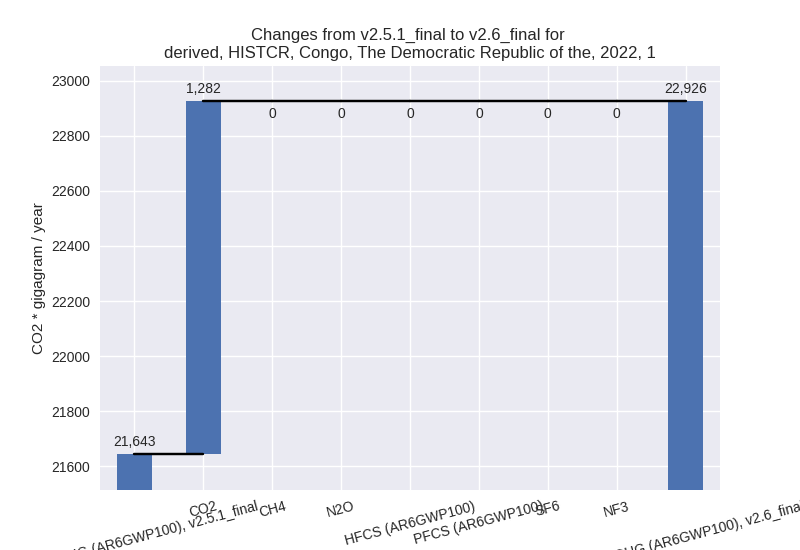
The changes come from the following subsectors:- 1.A: Total sectoral emissions in 2022 are 7896.69
Gg CO2 / year which is 34.4% of category 1 emissions. 2022 Emissions
have changed by 19.4% (1281.72 Gg
CO2 / year). 1990-2022 Emissions have changed by 0.9% (49.01 Gg CO2 / year). For 2022 the
changes per gas
are:
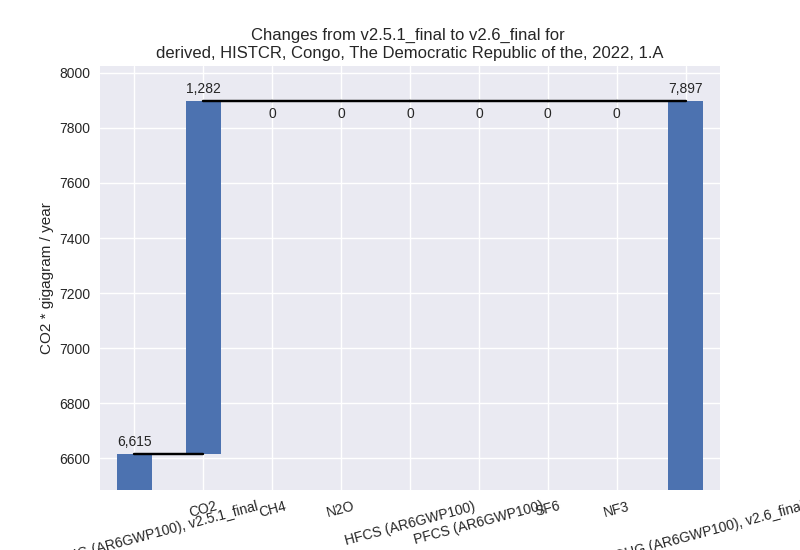
There is no subsector information available in PRIMAP-hist. - 1.B.1: Total sectoral emissions in 2022 are 12223.05 Gg CO2 / year which is 53.3% of category 1 emissions. 2022 Emissions have changed by 0.0% (0.44 Gg CO2 / year). 1990-2022 Emissions have changed by 0.0% (0.23 Gg CO2 / year).
- 1.B.2: Total sectoral emissions in 2022 are 2805.85 Gg CO2 / year which is 12.2% of category 1 emissions. 2022 Emissions have changed by 0.0% (0.00 Gg CO2 / year). 1990-2022 Emissions have changed by 0.0% (0.00 Gg CO2 / year).
- 1.A: Total sectoral emissions in 2022 are 7896.69
Gg CO2 / year which is 34.4% of category 1 emissions. 2022 Emissions
have changed by 19.4% (1281.72 Gg
CO2 / year). 1990-2022 Emissions have changed by 0.9% (49.01 Gg CO2 / year). For 2022 the
changes per gas
are:
- 2: Total sectoral emissions in 2022 are 3648.23 Gg CO2 / year which is 3.7% of M.0.EL emissions. 2022 Emissions have changed by 1.1% (39.49 Gg CO2 / year). 1990-2022 Emissions have changed by 0.1% (1.20 Gg CO2 / year).
- M.AG: Total sectoral emissions in 2022 are 46582.77 Gg CO2 / year which is 47.4% of M.0.EL emissions. 2022 Emissions have changed by 0.0% (0.00 Gg CO2 / year). 1990-2022 Emissions have changed by 0.0% (0.00 Gg CO2 / year).
- 4: Total sectoral emissions in 2022 are 22360.63 Gg
CO2 / year which is 22.8% of M.0.EL emissions. 2022 Emissions have
changed by 2.8% (603.67 Gg CO2 /
year). 1990-2022 Emissions have changed by 0.5% (62.58 Gg CO2 / year). For 2022 the
changes per gas
are:
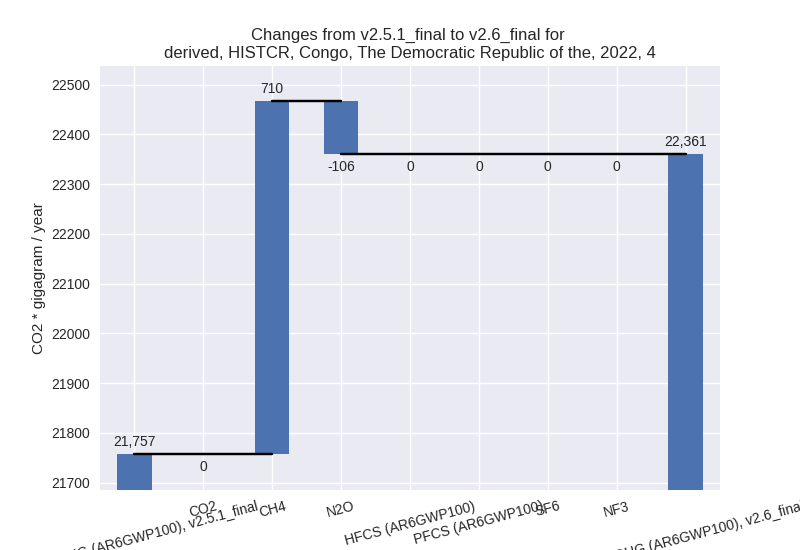
- 5: Total sectoral emissions in 2022 are 2723.67 Gg
CO2 / year which is 2.8% of M.0.EL emissions. 2022 Emissions have
changed by 223.4% (1881.57 Gg CO2 /
year). 1990-2022 Emissions have changed by 491.2% (2376.77 Gg CO2 / year). For 2022
the changes per gas
are:
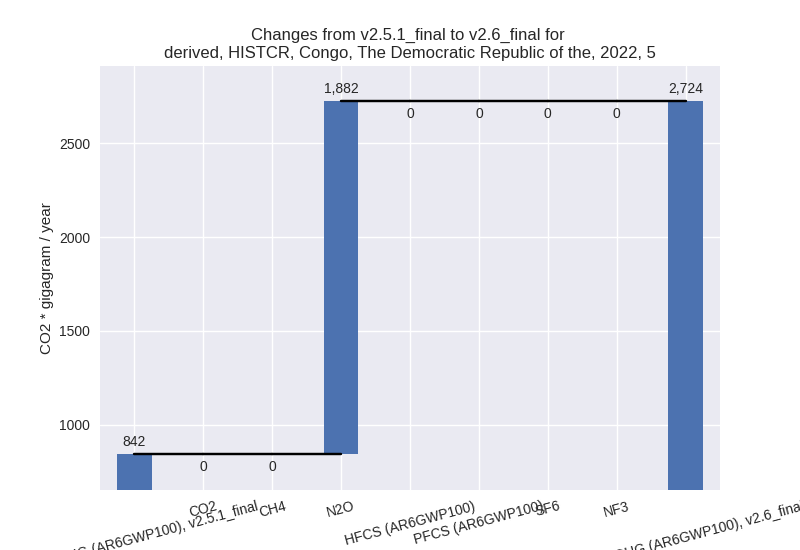
For 1990-2022 the changes per gas are: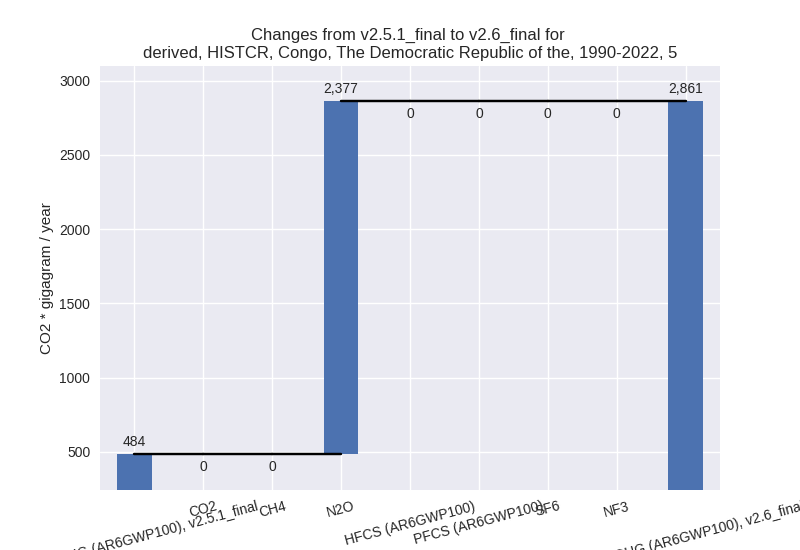
third party scenario (HISTTP):
Most important changes per time frame
For 2022 the following sector-gas combinations have the highest absolute impact on national total KyotoGHG (AR6GWP100) emissions in 2022 (top 5):
- 1: 5, N2O with 1881.57 Gg CO2 / year (223.4%)
- 2: 1.A, CO2 with 676.46 Gg CO2 / year (27.3%)
- 3: 4, CH4 with 578.72 Gg CO2 / year (3.1%)
- 4: 4, N2O with -106.13 Gg CO2 / year (-21.1%)
- 5: 2, HFCS (AR6GWP100) with 39.49 Gg CO2 / year (1.5%)
For 1990-2022 the following sector-gas combinations have the highest absolute impact on national total KyotoGHG (AR6GWP100) emissions in 1990-2022 (top 5):
- 1: 5, N2O with 2376.77 Gg CO2 / year (491.2%)
- 2: 4, CH4 with 51.65 Gg CO2 / year (0.5%)
- 3: 4, N2O with -25.88 Gg CO2 / year (-8.7%)
- 4: 1.A, CO2 with 25.87 Gg CO2 / year (1.2%)
- 5: 2, HFCS (AR6GWP100) with 1.20 Gg CO2 / year (0.1%)
Changes in the main sectors for aggregate KyotoGHG (AR6GWP100) are
- 1: Total sectoral emissions in 2022 are 25099.42 Gg
CO2 / year which is 31.5% of M.0.EL emissions. 2022 Emissions have
changed by 2.8% (676.90 Gg CO2 /
year). 1990-2022 Emissions have changed by 0.2% (26.10 Gg CO2 / year). For 2022 the
changes per gas
are:
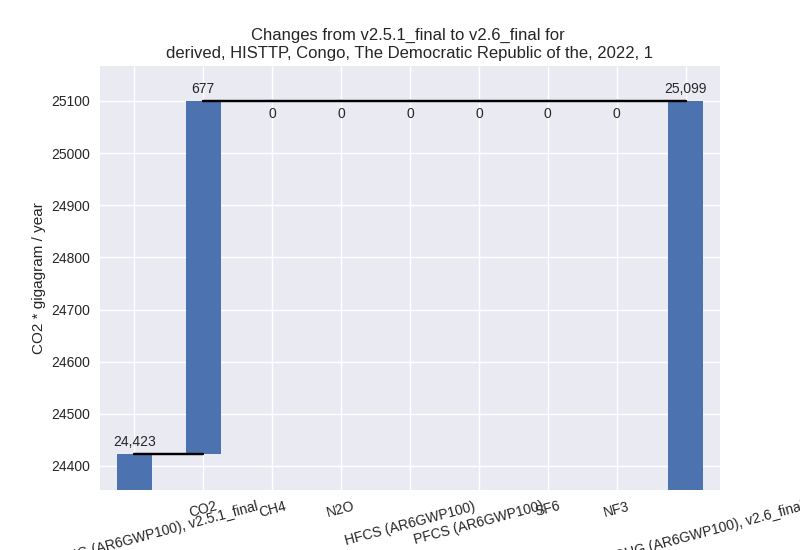
The changes come from the following subsectors:- 1.A: Total sectoral emissions in 2022 are 10070.52
Gg CO2 / year which is 40.1% of category 1 emissions. 2022 Emissions
have changed by 7.2% (676.46 Gg CO2
/ year). 1990-2022 Emissions have changed by 0.4% (25.87 Gg CO2 / year). For 2022 the
changes per gas
are:
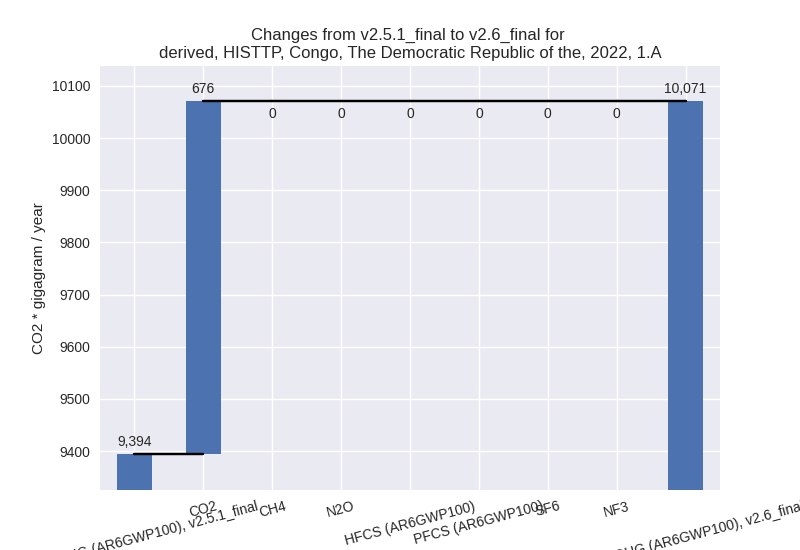
There is no subsector information available in PRIMAP-hist. - 1.B.1: Total sectoral emissions in 2022 are 12223.05 Gg CO2 / year which is 48.7% of category 1 emissions. 2022 Emissions have changed by 0.0% (0.44 Gg CO2 / year). 1990-2022 Emissions have changed by 0.0% (0.23 Gg CO2 / year).
- 1.B.2: Total sectoral emissions in 2022 are 2805.85 Gg CO2 / year which is 11.2% of category 1 emissions. 2022 Emissions have changed by 0.0% (0.00 Gg CO2 / year). 1990-2022 Emissions have changed by 0.0% (0.00 Gg CO2 / year).
- 1.A: Total sectoral emissions in 2022 are 10070.52
Gg CO2 / year which is 40.1% of category 1 emissions. 2022 Emissions
have changed by 7.2% (676.46 Gg CO2
/ year). 1990-2022 Emissions have changed by 0.4% (25.87 Gg CO2 / year). For 2022 the
changes per gas
are:
- 2: Total sectoral emissions in 2022 are 3534.83 Gg CO2 / year which is 4.4% of M.0.EL emissions. 2022 Emissions have changed by 1.1% (39.49 Gg CO2 / year). 1990-2022 Emissions have changed by 0.1% (1.20 Gg CO2 / year).
- M.AG: Total sectoral emissions in 2022 are 28746.95 Gg CO2 / year which is 36.0% of M.0.EL emissions. 2022 Emissions have changed by 0.0% (0.00 Gg CO2 / year). 1990-2022 Emissions have changed by 0.0% (0.00 Gg CO2 / year).
- 4: Total sectoral emissions in 2022 are 19671.53 Gg
CO2 / year which is 24.7% of M.0.EL emissions. 2022 Emissions have
changed by 2.5% (472.59 Gg CO2 /
year). 1990-2022 Emissions have changed by 0.2% (25.77 Gg CO2 / year). For 2022 the
changes per gas
are:
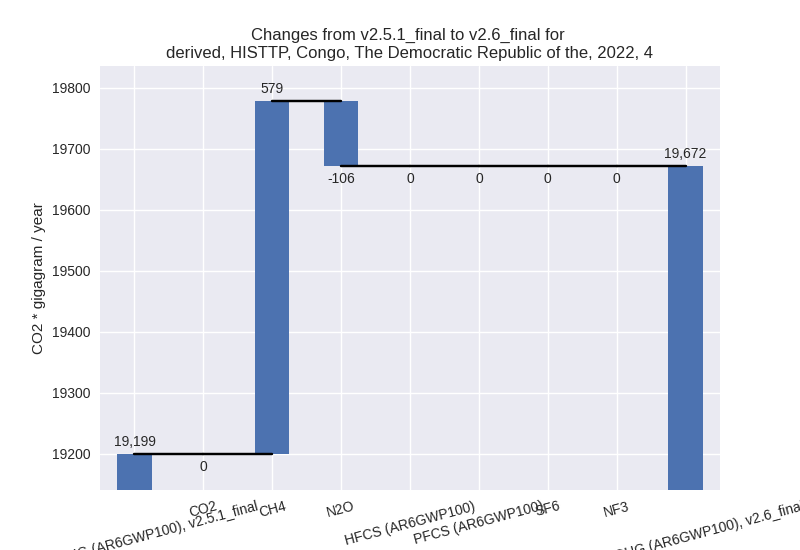
- 5: Total sectoral emissions in 2022 are 2723.67 Gg
CO2 / year which is 3.4% of M.0.EL emissions. 2022 Emissions have
changed by 223.4% (1881.57 Gg CO2 /
year). 1990-2022 Emissions have changed by 491.2% (2376.77 Gg CO2 / year). For 2022
the changes per gas
are:
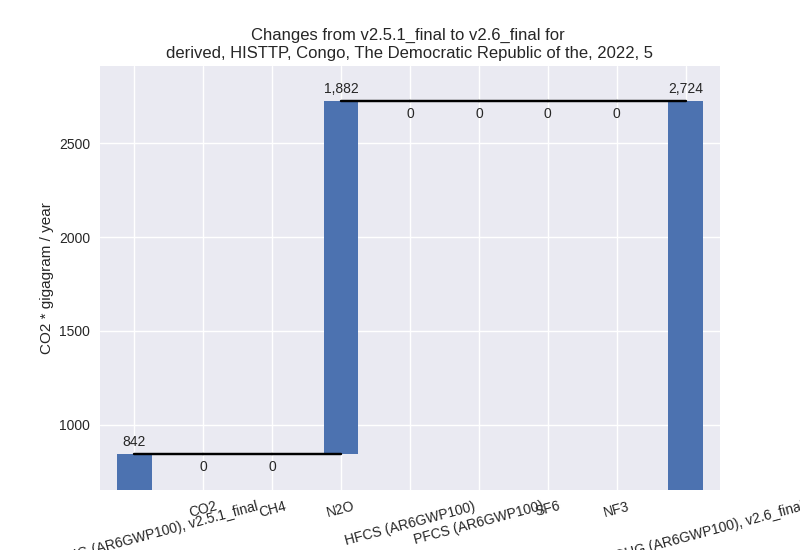
For 1990-2022 the changes per gas are: